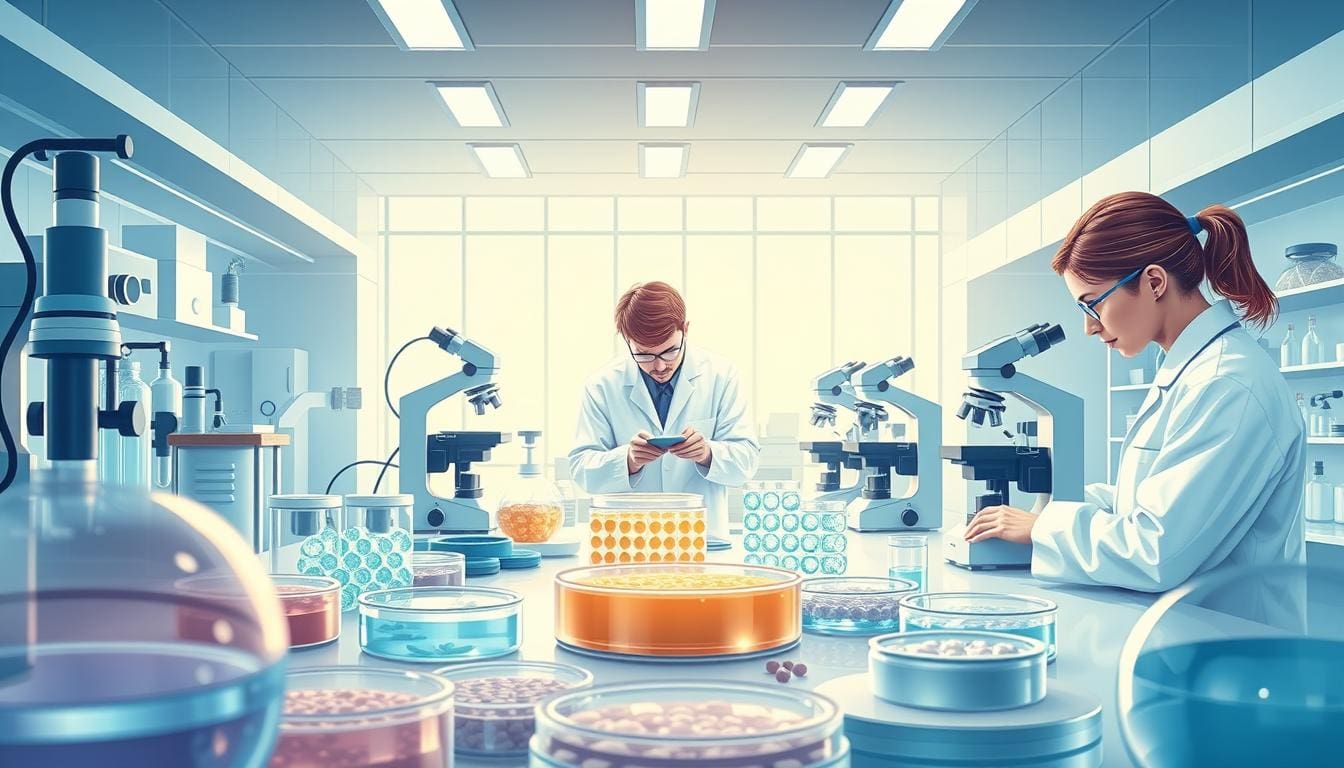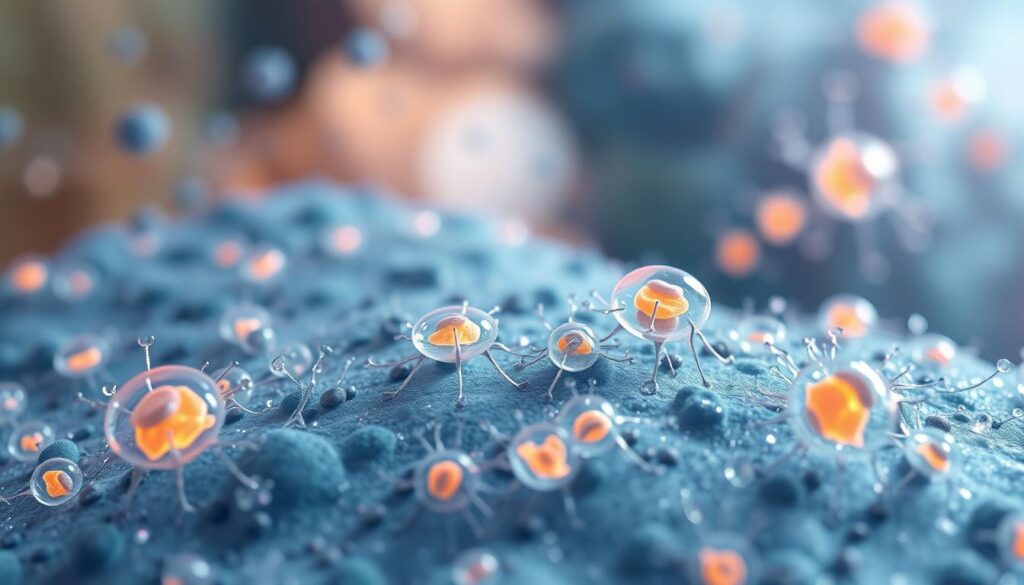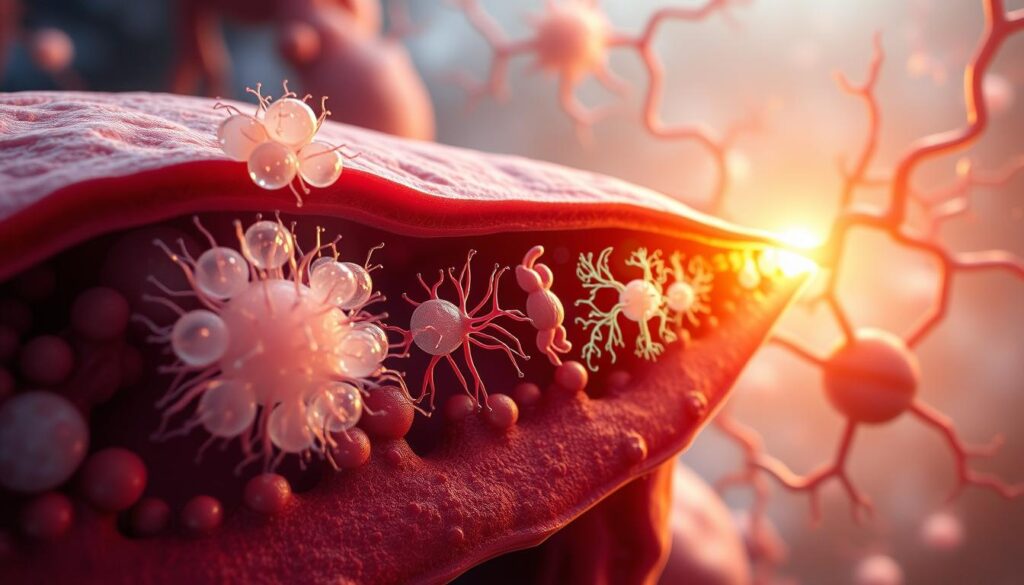
We are excited to share seven surprising stem cell research facts with you. Stem cells are special cells that can turn into many different types. This makes them key in regenerative medicine.
At Liv Hospital, we offer top-notch healthcare for international patients. We use the latest in stem cell therapy benefits. Our team works hard to give you the best care, always improving and innovating.

Stem cells are changing medicine in big ways. They can fix damaged tissues, which is a huge breakthrough. The stem cell regeneration process is key to this change, opening doors to new treatments for many diseases and injuries.
There are mainly two types of stem cells: embryonic and adult. Each has its own uses. Embryonic stem cells can turn into any cell type, which is super useful for research and treatments.
Adult stem cells can only turn into certain cell types. But, scientists have made big strides. They can now grow human embryonic stem cells in labs. This helps with drug testing and transplant medicine. Also, adult cells can be turned into embryonic-like cells, opening up more research areas.
Stem cell research is changing medicine fast. Scientists are learning how to use different stem cells to treat many conditions. They’re working on fixing heart damage, repairing spinal cords, and treating diseases that get worse over time.
Stem cells are going to change healthcare a lot. With more research and new tech, stem cell therapy could make a big difference. It could help patients live better lives.

Stem cells are called the body’s “master cells” because they can turn into many different cell types. This ability is key for fixing damaged tissues and organs. At Liv Hospital, we’re looking into how stem cells can help treat many diseases and injuries.
Stem cells are special because they can make copies of themselves and turn into different cell types. This makes them very important for medical research and treatments. The stem cell regeneration process is carefully controlled, helping them meet the body’s needs.
There are different types of stem cells, like embryonic and adult stem cells. Each type has its own uses in medicine. Knowing about these differences is key to using stem cells effectively.
Stem cells can become many types of cells, like nerve, muscle, and blood cells. This ability is very promising for treating many diseases and injuries. For example, they could help fix damaged heart tissue, which could treat heart disease.
“The ability to reprogram adult cells into induced pluripotent stem cells has revolutionized the field of stem cell research, opening up new possibilities for personalized medicine.”
Stem cells can be found in many parts of the body, like bone marrow, blood, and umbilical cord blood. These places are full of stem cells, which could lead to new treatments for many conditions.
| Stem Cell Source | Potential Applications |
|---|---|
| Bone Marrow | Treatment of blood disorders, bone diseases |
| Umbilical Cord Blood | Regenerative medicine, treatment of genetic disorders |
| Adipose Tissue | Regenerative therapies, cosmetic applications |
As we keep studying stem cell applications in medicine, we’re finding new ways to treat complex diseases. Our research and trials are leading to innovative treatments that use stem cells.
Adult stem cells are found in many body tissues. They are key to health and repair. At Liv Hospital, we see how important they are for keeping tissues healthy and helping the body fix itself.
Stem cells are not just for growing embryos; they are in adult bodies too. These cells are in:
Studying these stem cells has led to new ways to fix damaged tissues. “Finding stem cells in adult tissues has changed how we fix and engineer tissues,” , a top researcher.
Umbilical cord blood is also a great source of stem cells. This blood, usually thrown away after birth, has stem cells that can become different blood cells.
Using stem cells from umbilical cord blood has big benefits. It’s easy to get and safer than other sources. At Liv Hospital, we’re looking into how these stem cells can help treat diseases.
By using stem cells from different places, we can create new treatments. These treatments can make patients’ lives better. As we learn more about stem cell therapy benefits, we’re leading the way in using this knowledge to help our patients.
Our bodies depend on stem cells every day to stay healthy. They help keep our tissues and organs in top shape by constantly renewing and repairing them.
The human body is made up of trillions of cells, and many have a short lifespan. Stem cells replace or repair damaged cells, making sure our tissues and organs work right. This is key to staying healthy and avoiding sickness.
For example, our skin cells are constantly being replaced because of wear and tear. Stem cells in the skin help make new skin cells, keeping our skin looking good and strong. The gut’s lining also gets renewed every few days, thanks to stem cells.
Our daily activities and the environment can harm our cells. Stem cells are vital in fixing this damage, keeping our tissues and organs in good shape. They help fix everything from small cuts to internal injuries, helping our body heal.
“Stem cells are essential for the body’s natural repair processes, replacing damaged or dying cells and maintaining tissue homeostasis.”
At Liv Hospital, we know how important stem cells are for our health. Our team works hard to understand and support our body’s stem cell processes. We aim to improve overall well-being and advance medical treatments.
Stem cells are not all the same. They come in different types, each with unique characteristics. At Liv Hospital, we understand the importance of these differences. We use this knowledge to make the most of stem cells in medical treatments.
There’s a big difference between embryonic and adult stem cells. Embryonic stem cells come from early-stage embryos. They can turn into almost any cell in the body. This makes them very useful for research and possible treatments.
Adult stem cells are found in adult tissues. They can turn into a few different cell types. Even though they’re not as versatile as embryonic stem cells, they’re important for fixing and keeping tissues healthy.
Another important difference is in how powerful these cells are. Pluripotent stem cells can become every type of cell in the body. This makes them very powerful for medical research and fixing damaged tissues. On the other hand, multipotent stem cells can turn into a few different cell types, but only within a specific group or tissue.
Here’s a quick summary of these stem cell types:
Knowing these differences is key for improving stem cell research and treatments. At Liv Hospital, we’re dedicated to leading in this research. We want to give our patients the best care possible.
Induced pluripotent stem cells have changed how we see cell reprogramming. This new tech lets scientists turn adult cells into a state like embryonic stem cells. This way, they avoid the ethical issues tied to using embryos in research.
Induced pluripotent stem cells (iPSCs) are made by changing adult cells, like skin or blood cells, into a pluripotent state. They can turn into almost any cell type in the body, just like embryonic stem cells. This breakthrough has changed stem cell research by giving us a nearly endless source of cells for study and possible treatments.
At Liv Hospital, we see the huge promise of iPSCs in personalized medicine. By making iPSCs from a patient’s own cells, we can create treatments that are less likely to be rejected by the body.
Using iPSCs avoids the ethical issues of using embryonic stem cells, as it doesn’t harm embryos. This ethical plus, along with the chance to make stem cells specific to a patient, makes iPSCs a great choice for researchers. It lets us study cells from patients to better understand diseases and create targeted treatments.
Also, iPSCs bring big research benefits, like being able to study diseases in a lab and test treatments on cells from patients. This speeds up finding new treatments and helps us understand complex diseases better.
As we keep exploring iPSCs, we’re all in on making stem cell research and therapy better. Our team at Liv Hospital is working hard to use iPSCs to help patients and grow the field of regenerative medicine.
Stem cells can now be grown in labs, changing regenerative medicine. This lets us study and test new treatments. It also helps us create new therapies.
Growing stem cells in labs is a complex task. It needs a deep understanding of stem cell biology. We use special media and growth factors to help them grow.
“Growing stem cells in labs has changed our field. It lets us study them closely and create new treatments we never thought possible.”
“The ability to culture stem cells has been a game-changer for our field. It allows us to study stem cell behavior in detail and develop new therapies that were previously unimaginable.”
Lab-grown stem cells are great for drug testing and disease modeling. They help us understand diseases better and test treatments.
| Disease | Stem Cell Application | Potential Benefits |
|---|---|---|
| Parkinson’s Disease | Dopaminergic neuron generation | Cell replacement therapy |
| Heart Disease | Cardiomyocyte generation | Heart tissue repair |
| Diabetes | Pancreatic islet cell generation | Insulin production restoration |
At Liv Hospital, we’re using these stem cell advances to help patients. Our team works hard to create new treatments using stem cells.
We’re excited about the future of stem cell therapy. It could change medicine and help people all over the world.
Many know the basics of stem cells, but there’s more to learn. At Liv Hospital, we’re always learning about new developments. This helps us give our patients the best treatments.
Scientists have found new ways to turn adult cells into stem cells. This is a big step for personalized medicine. It means treatments can be made just for you.
Stem cells also help fix damaged tissues and organs. This is great news for people with diseases that were once thought to be untreatable.
New stem cell research is leading to better treatments. For example, stem cell therapy benefits can help with diseases like Parkinson’s and heart problems.
At Liv Hospital, we use these new technologies in our treatments. Our team works hard to give patients the latest stem cell therapies. We want to make sure they get the best care.
As research keeps getting better, we expect even more exciting uses for stem cells. The future of healthcare is bright, and we’re ready to lead the way.
Stem cells are key to living longer and healthier. At Liv Hospital, we lead in research and treatments using stem cells. We aim to boost healthspan and vitality.
Studies show stem cells are vital in aging. Stem cell therapy might reverse aging by refreshing tissues and organs. Our team is looking into how stem cells can boost cellular health.
Here’s a quick look at some anti-aging research findings on stem cells:
| Research Area | Findings | Potential Applications |
|---|---|---|
| Cellular Rejuvenation | Stem cells can rejuvenate aged cells | Reversing age-related decline |
| Tissue Regeneration | Stem cells can regenerate damaged tissues | Treating age-related diseases |
| Organ Function | Stem cells can improve organ function | Enhancing overall healthspan |
Regenerative medicine uses stem cells to fix or replace damaged tissues and organs. It’s a big step towards longer life. It aims to not just add years but also quality years.
The perks of stem cell therapy in regenerative medicine are:
As research grows, stem cells will become more vital in medicine. They promise longer, healthier lives.
Stem cells have a huge role in treating over 70 diseases. They are becoming a key part of new treatments for many health issues. This includes diseases like autoimmune disorders and degenerative conditions.
At Liv Hospital, we focus on giving our patients the newest stem cell therapies. We want to make sure they get the best treatments out there. Our team works hard to improve regenerative medicine.
Some stem cell treatments have been approved by the FDA. This is a big step forward for regenerative medicine. These approved treatments help with blood cancers, eye problems, and more.
Approved Treatments:
There are many clinical trials looking into stem cell therapy. They are exploring treatments for diseases like Parkinson’s, Type 1 Diabetes, and heart failure. These trials are in different stages, from Phase I to Phase III.
| Disease/Condition | Stem Cell Type | Current Stage |
|---|---|---|
| Parkinson’s Disease | Mesenchymal Stem Cells | Phase II Trials |
| Type 1 Diabetes | Hematopoietic Stem Cells | Phase III Trials |
| Heart Failure | Cardiac Stem Cells | Phase I Trials |
The future of stem cell therapy is exciting. It could lead to new treatments in many areas of medicine. As research gets better, we’ll see even more innovative treatments.
At Liv Hospital, we’re always looking for the latest in stem cell research. We want to give our patients the best care possible. We keep up with all the new developments in stem cell therapy.
The field of stem cell science is on the verge of a new era. This is thanks to new technologies and fresh ideas. At Liv Hospital, we’re committed to leading these advancements. We aim to better patient care and explore new healthcare possibilities.
New tools like gene editing, biomaterials, and more are opening up new paths for stem cell use. Gene editing, for example, lets us make precise changes to stem cells. This boosts their healing power. Biomaterials help stem cells grow and change into different types of cells, key for fixing damaged tissues.
Some of the key emerging technologies in stem cell science include:
Stem cell therapies hold a lot of promise, but there are hurdles to cross. We need to make sure these treatments are safe and work well. We also face issues like immune rejection and ethical debates. Scientists are working hard to find solutions to these problems.
Some strategies to tackle these challenges include:
At Liv Hospital, we’re all about pushing stem cell research and treatment forward. We’re using the latest technologies and working together to solve problems. Our goal is to improve patient care and help stem cell science grow.
Leading medical institutions are changing stem cell treatments in big ways. They use a mix of biology, medicine, and tech to make new therapies. This is a big step forward.
Stem cell therapy is getting a major update. Top places like Liv Hospital are working together. They bring together experts from different fields to make new treatment plans.
This teamwork helps us:
Stem cell applications in medicine are growing fast. Our team is always learning and teaching others. We know how important it is to keep healthcare pros up to date.
We’re always looking to improve stem cell therapy. But we do it with the highest ethics. We’re open about our research, get clear consent from patients, and follow strict safety rules.
We’re always looking for new ways to use stem cells. From fixing damaged tissues to making targeted treatments. Our goal is to make treatments better for patients.
“The future of stem cell therapy lies in its ability to change how we treat diseases. By working together and being ethical, we can make big changes in patient care.”
Liv Hospital Research Team
We’re excited to keep improving stem cell treatments. Our goal is to give top-notch care that’s both new and caring. Our work shows the power of teamwork and the big impact stem cells can have on medicine.
The world of stem cells is both fascinating and fast-changing. It holds great promise for better health. Through these fun facts, we see how stem cells’ special abilities and healing power are key to modern medicine.
At Liv Hospital, we’re dedicated to exploring stem cell science further. This ensures our patients get the best from the latest in this field. Research shows a future where stem cells could help treat many diseases and injuries, making life better for many.
As research goes on, we’re excited for new findings and big steps forward. We aim to lead in stem cell science. This way, we can offer our patients the most advanced and effective treatments.
Stem cells are special cells that can turn into different types of cells. They help fix damaged tissues and organs. They keep our bodies working well by constantly renewing tissues and organs.
There are many types of stem cells. These include embryonic stem cells, adult stem cells, and induced pluripotent stem cells (iPSCs). Embryonic stem cells can become many types of cells. Adult stem cells are more limited. iPSCs are made from adult cells that are changed back to a stem cell state.
iPSCs are a big deal in stem cell research. They let scientists make stem cells without using embryos. This solves ethical problems and opens doors for personalized medicine.
Stem cell therapy uses stem cells to treat many conditions. They can fix damaged tissues and organs. Their ability to become different types of cells makes them key for fixing the body.
Texas A&M University (Vital Record): Fast Facts: Stem Cells 101
British Heart Foundation (BHF): Breakthroughs in Stem Cell Research
University of California, Irvine (UCI) Stem Cell Research Center: Stem Cell Basics
Subscribe to our e-newsletter to stay informed about the latest innovations in the world of health and exclusive offers!
WhatsApp us